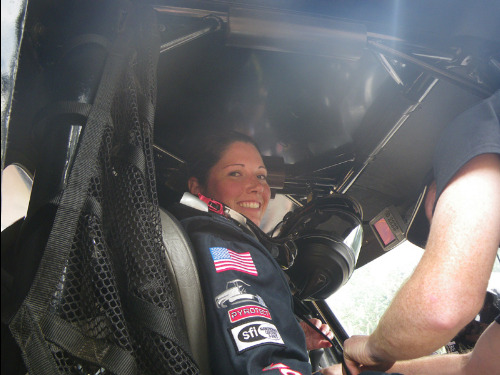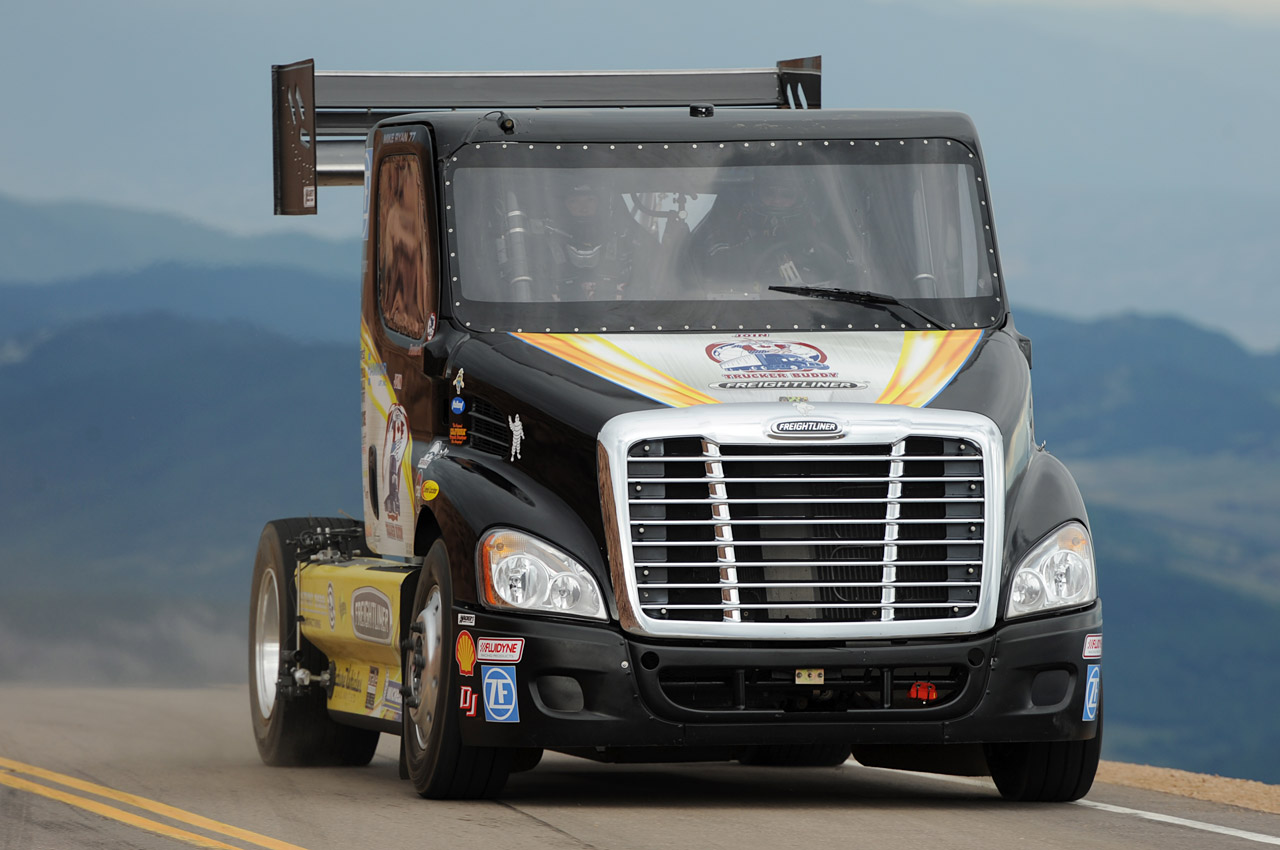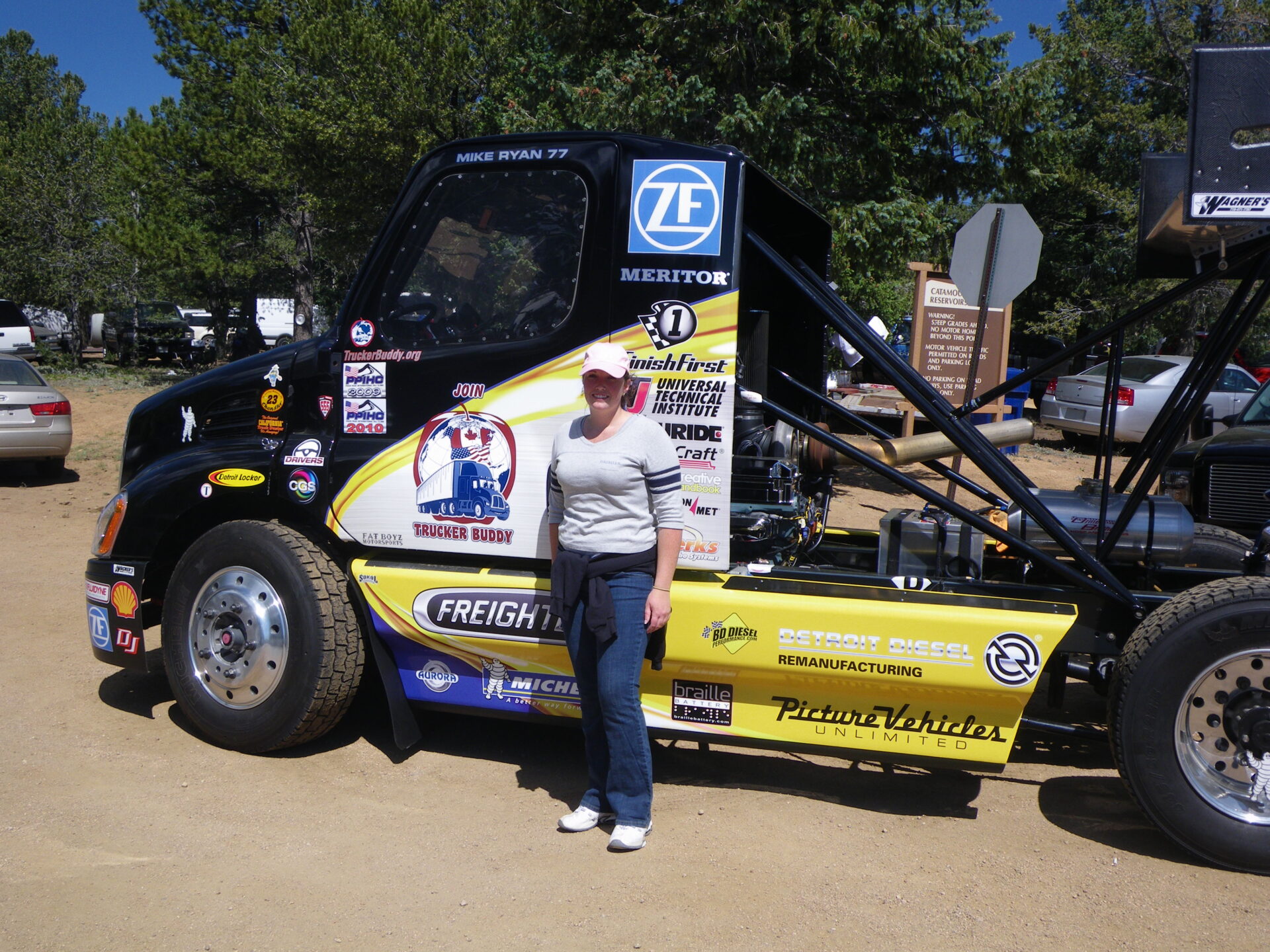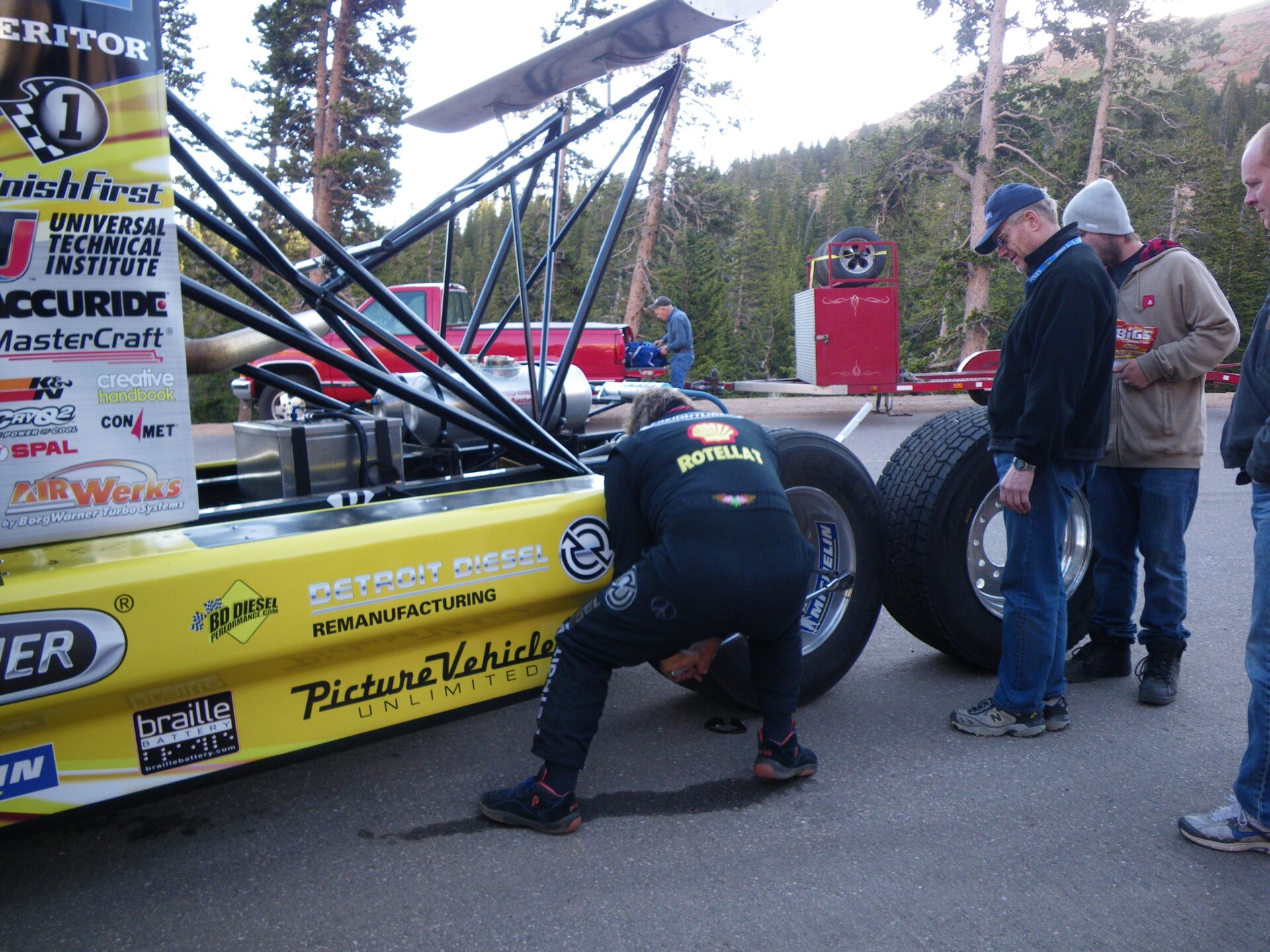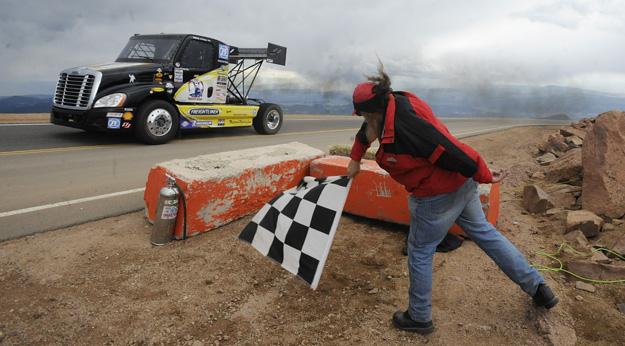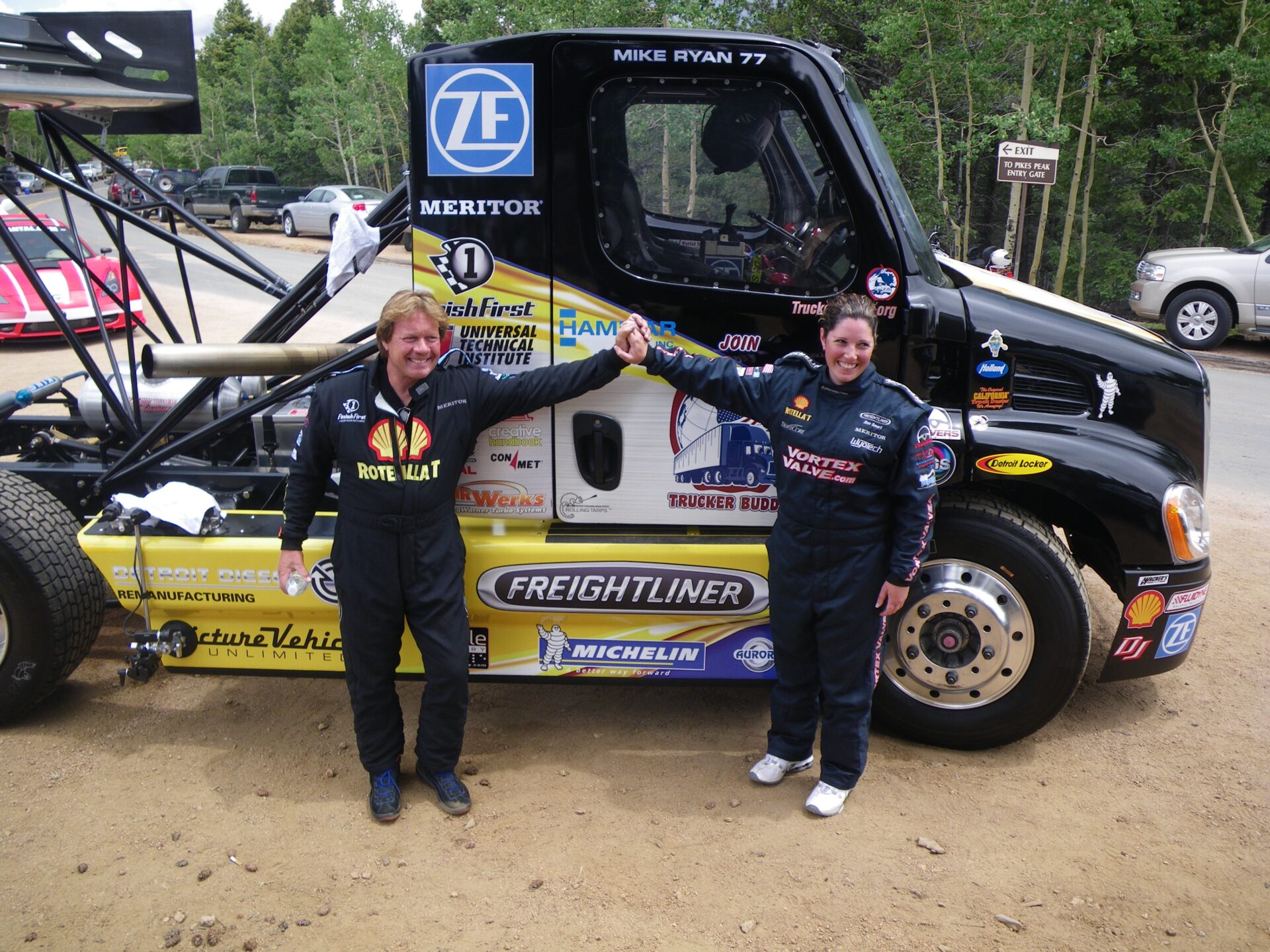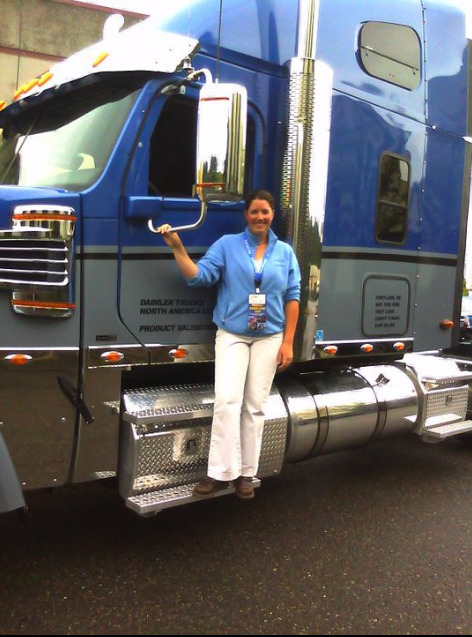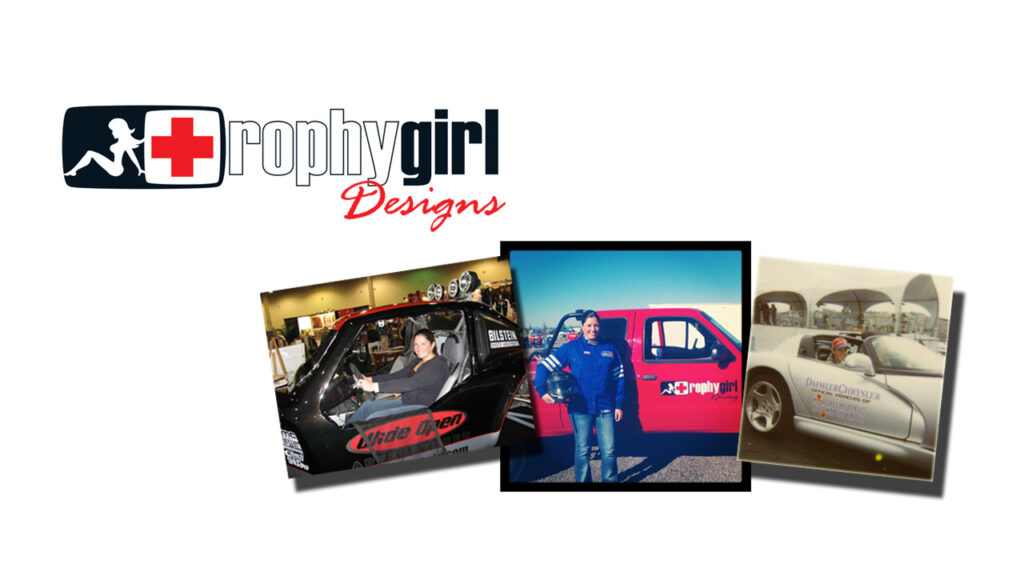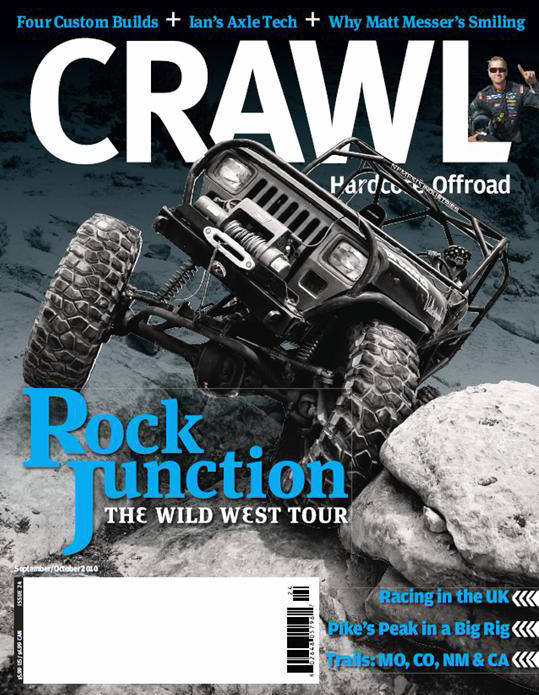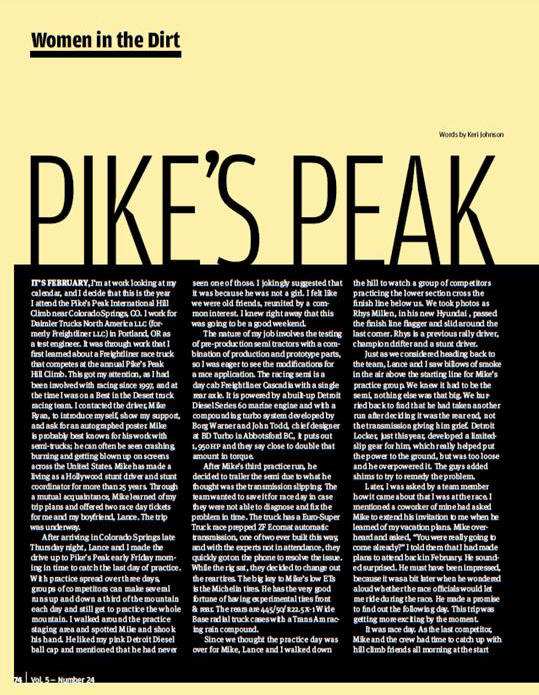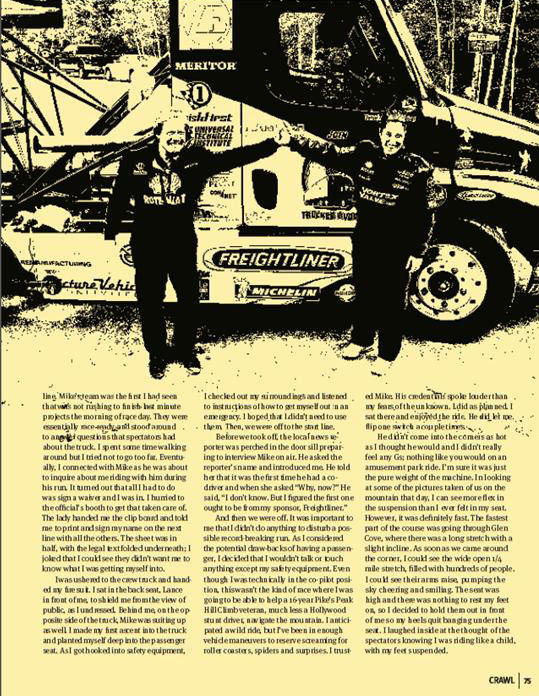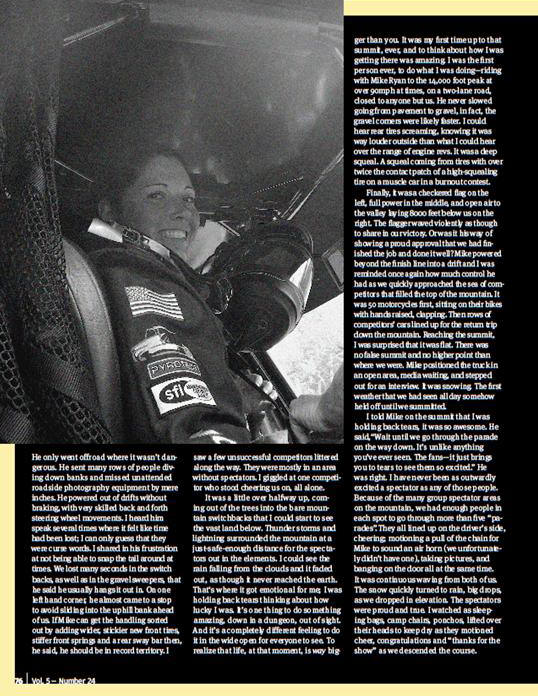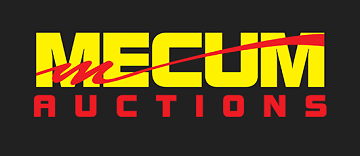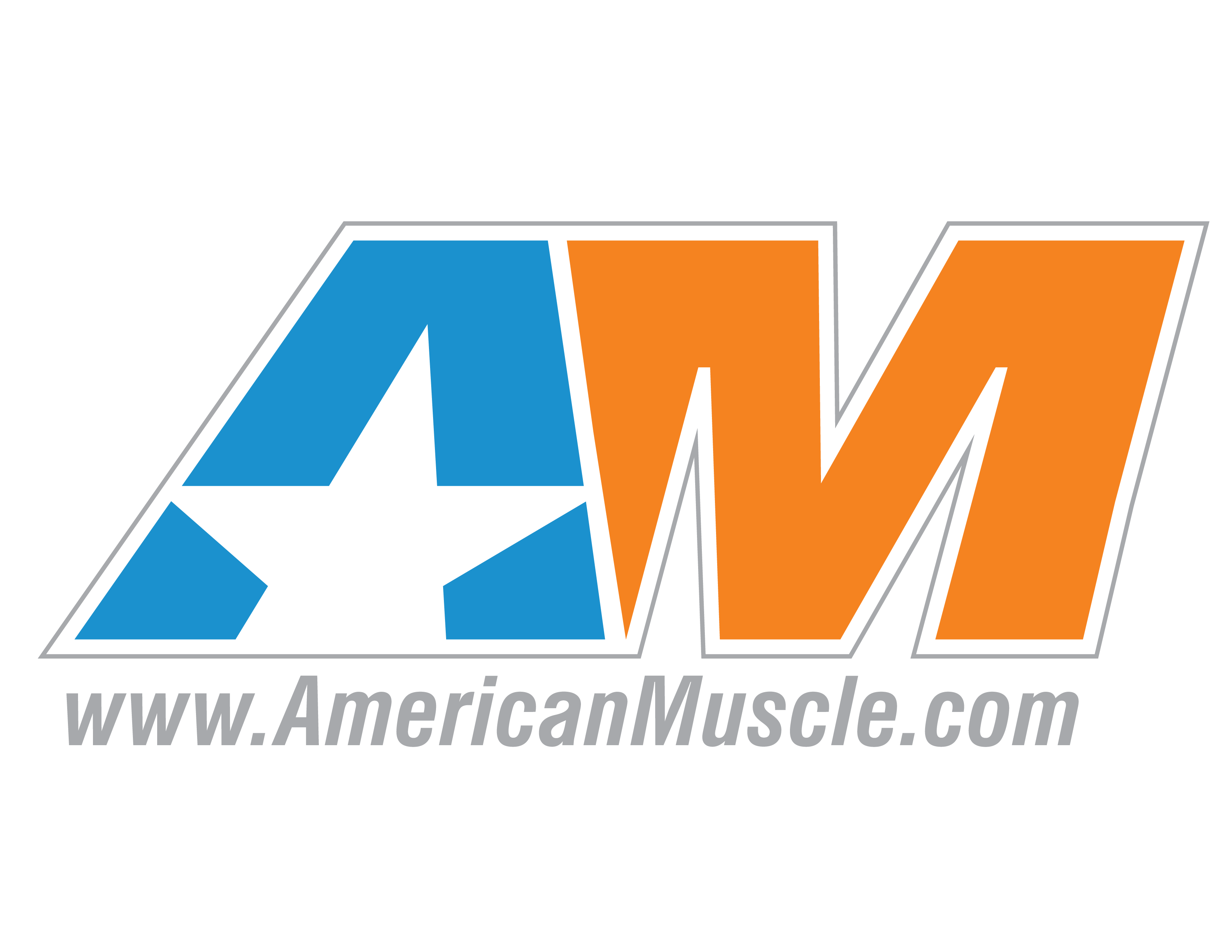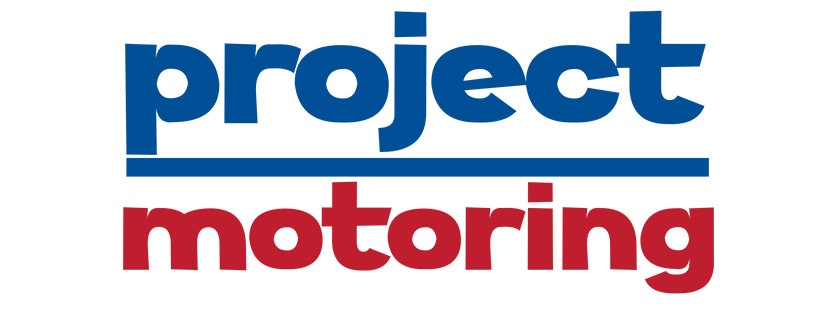Our guest has had her class A commercial driver’s license (CDL) since 2008. She has logged thousands of highway miles driving across the country. Some of those include the snow-covered passes of Montana with a loaded 52 foot trailer during winter testing. She has also been trained and qualified to drive on the durability test track at the Bosch Automotive Proving Grounds as well as the track at the PACCAR Technical Center.
In addition to her training Keri Weishaar co-drove with Hollywood stunt driver and then 16-year Pikes Peak International Hill Climb competitor Mike Ryan at the 2010 Pikes Peak International Hill Climb and today finds herself designing safety equipment for Trophy Girl Designs, and she’s here to tell us all about her automotive journey.
Spotlight
Keri Weishaar - Founder & Lead Engineer for Trophy Girl Designs
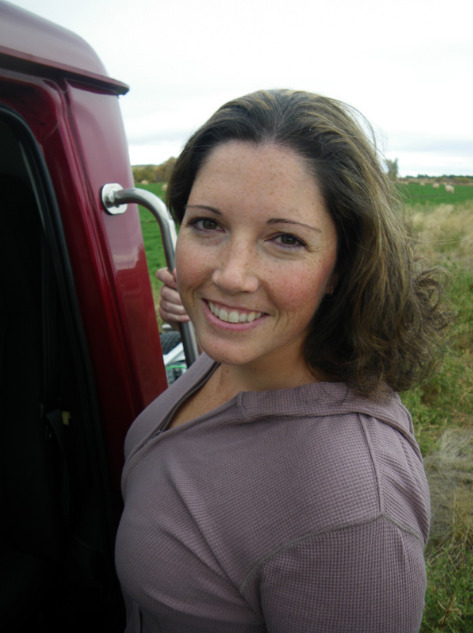
Trophy Girl Designs was established in 2011 when a simple product showed big potential. It all started when Keri was searching for a specialty fire extinguisher mount for her 2002 Ford Ranger prerunner. She was never impressed with the standard brackets that came with fire extinguishers. They were either awkward to mount, made out of cheap plastic, or cumbersome to access. She thought the prices were too high on the mounts she did find, so she set out to make her own. When finished, she posted her work on a local off-road forum and offered to make more. She set a price for her friends and with 9 orders overnight and 90 within the first 6 months, Keri decided to get serious about her good fortune. She decided to pull all her skills and resources into one place, and that's this website. The skills she doesn't use in her day job, she wants to put to good use helping others. Whether it be designing, drafting, production, or commercial driving, she would like to exploit them here.

Contact: Keri Weishaar at Visit Online!![]()
![]()
Notes
- Let’s talk about The who/what/where/when/how of Keri? What’s your petrol-head origin story… How did you get into Big-Rigs? Did you come from a trucking family?
- So there’s more than meets the eye here, you actually have a degree in Mechanical Engineering… What drove you (pun intended) to get a CDL? Why?
- What’s it like to drive a semi? To be a trucker? The life of a trucker?
- Best/Worst Moments in trucking?
- Have you used any of the new SEMI-TRUCK simulators that many of us are seeing on social media? Is that good training? A good aid, or nothing substitutes real life experience?
- In some of the photos on your website, I see evidence of semi-truck (super truck) racing; how did you get into that? It’s really popular in Europe, what’s it like to race a semi?
- Trucking was made more popular in the last 10 years by shows like “Ice Road Truckers” and “World’s Most Dangerous” roads and other programs on History channel. How “real” is that? What do you think of those programs?
- Let’s talk about what you’re doing at Trophy Girls Design, with respect to safety – what types of gear or products are you manufacturing?
and much, much more!
Transcript
[00:00:00] Break Fix podcast is all about capturing the living history of people from all over the autos sphere, from wrench, turners, and racers to artists, authors, designers, and everything in between. Our goal is to inspire a new generation of Petrolhead that wonder, a. How did they get that job or become that person?
The road to success is paved by all of us because everyone has a story.
Our guest has had her class A commercial driver’s license, also known as A C D L since 2008. She has logged thousands of highway miles driving across the country. Some of those include the snow covered passes of Montana with a loaded 52 foot trailer during winter testing. She has also been trained and qualified to drive on the durability test track at the Bosch Automotive proving grounds, as well as the track at Paccar Technical Center.
In addition to training Carrie Wise, co drove with Hollywood Stunt Driver and [00:01:00] then 16 year Pikes Peak International Hill Climb competitor Mike Ryan at the 2010 Pikes Peak International Hill Climb and today finds herself designing safety equipment for trophy roll designs. She’s here to tell us more about her automotive journey.
With that, let’s welcome Carrie to break fix. That’s right, and my co-host tonight is the one and only Mountain man, Dan. So Carrie, welcome to the show. Why don’t we get started like all good break fix stories. Tell us the who, what. Where and when of carry. How did you get into big rigs of all things? Did you come from a trucking family?
Yeah, I get that question a lot. I had three generations back home. It was either logging or the hospital where the two industries, very small community, and I did grow up wanting to be a chip truck driver, just like all the trucks I saw drive in and out of the mill that my dad and my grandpa and my brother worked at.
Luckily, I’m not. I’m a little bit better. I’ve achieved a few more things. Speaking of which, [00:02:00] on your resume it says you got a degree in mechanical engineering, you also have a C D L, so you’re sort of dual hatted here a little bit more than meets the eye. Why? So my goal was to enter into the automotive industry as a career.
With my engineering degree, and I was able to do that in 2007. And in 2008, the position I entered into required that I have a C D L and I delivered trucks to the proving grounds in Indiana, and then I’d fly back home. I would leave them there to die. They would die on the durability track. I would go back home and manage all the failures that happened, and I was housed at the headquarters where the design engineers were.
So I’d intercept these broken parts and say, This is how poorly your part performed. Can you fix it for. I did that a few times, got a lot of miles under my belt, and then I switched to a different company. I’ve only ridden in a semi [00:03:00] one time, and it was actually pretty recently and it, it was an interesting experience, but for those of us that have only had the privilege to drive regular passenger vehicles, What’s it like to drive something so big and how did you learn and how different is it to learn to drive a semi than a passenger vehicle?
It can be really intimidating because of the size of it. You’re in charge of this massive machine. It can be a little scary that if you don’t do the right thing, it could do a lot more damage than a regular car. The first couple times I went cross country out on the road in a truck, I realized the road really does belong to truckers.
The rest of us just commingle in between them. But really it’s a trucker’s world out there, and it really doesn’t seem like it until you do it yourself. I mean, you have to fit in around them. They can’t stop as quickly. Not everyone drives carefully around truckers, but you should. If you don’t, they’ll get you every time.
They’ll win every time. So I wonder if it’s more like when we’re on the racetrack, they say all the [00:04:00] time, we have to be situationally aware. We have to look way ahead. Our heads are on a swivel, as they say, right? We’re constantly looking around. Is that the same for being a trucker or do you get a moment where you can actually relax when you’re behind the wheel?
It’s constantly watching. The side mirrors can’t really see out the back unless you’re like in a day with no trailer. So constantly watching the mirrors, even looking out your driver’s window. When there’s nobody nearby, you can yeah, relax a little bit. Honestly, over the first five years that I got in a truck and drove, I would sweat and I would have white knuckle grip on the steering wheel.
I was a good driver, but I was able to control the nerves. It’s not easy, and now it’s just like driving anything else because I’ve driven some larger trucks in my years as well. For me, the biggest thing out on the road is it’s not so much you are driving, you have to pay attention to everyone else’s driving.
Almost like you’re a teacher looking after a bunch of toddlers and all the small cars are the toddlers. ’cause you don’t know if they’re gonna just turn in front of you. [00:05:00] Did you find it difficult trying to deal with other drivers on the road that are not respectful of the big trucks? It gets irritating.
You know, I’d say most people are aware and respectful of the size of us and the space that we have to do the maneuvers that we need to do. Then yes, sometimes there’s people that kind of make your heart skip a beat, like. You just got in front of me. You better keep going. I really hope you don’t suddenly slam on the brakes because that was a bad move.
One thing, when I was getting my license, when I was younger driver coach that I had when I was getting my regular license, one of the best lessons that he told me, and I’ve taught it to all the young drivers, I teach Drive on the road. He was like, there’s right of way. There’s right of weight. You might have right of way coming down to a open.
He’s like, there’s a semi or something coming. They’ve got right of weight. They can’t stop as fast as you let them go. And for the listeners out there, that’s wait, W E I G H T, not w a i t. Just wanted to clarify the right of weight. I like that though, the right of weight. I [00:06:00] do feel that I have grown a newfound respect for.
Truckers in the trucking industry, especially towing the race cars and trailers and enclosed trailers and things like that. It doesn’t compare. It’s apples and chainsaws. I get that. But there are things that irritate me and it’s like, do you not realize that I’m, I’m towing something. I got something behind me.
Right. It’s not that easy. Even if you’re in a pickup or an SS u V. So I definitely get it and, and it’s amplified on that larger scale plus when you’re loaded down, but there’s a lot of training involved in that. Kind of walk us through what you had to do, what the exercises were like. I mean, you knew how to drive a car, you drove yourself to the training center to become a semi driver, but what was the rest of it like?
My situation was a little bit unique. It was normal for people to go through training within my company. We didn’t have like a third party person train us, or I didn’t go to like specifically a truck driving school. But in my position at the time, I was required to be potentially decking a [00:07:00] bobtail truck.
So that means without a trailer. Onto the back of another bobtail truck, so it’s not bobtail anymore, it’s got another truck up on the fifth wheel of it and taking that to Indiana. So that was more than a Class B requirement. That was a Class A at that point. In fact. Did you have your A Class CDLs? And for our listeners that aren’t aware of it, there’s a class and B class, as you were saying, when you’re going down the road and see a dump truck.
That’s a B class ’cause it doesn’t have trailer behind it. But if the dump truck has a trailer behind it with air brakes and stuff, then sometimes you’re required to have the A, because you can drive a heavy duty truck bobtail with a Class B license on the road. Normally employees would get trained. To drive with a Class B, get some miles under their belt and then go for the Class A.
But I went for the class A right away, planned for three weeks, but we only used two and he assigned me off. Normally he would train with 45, 47 foot trailer, but those weren’t available, so we used a 52 foot. And this was in [00:08:00] the Portland area, so that included some mountain driving. He just said I was one of his best students.
And I think a lot of that has to do with being a female, which I’ve heard repeated over and over again. Same thing with my forklift training. I got a hundred percent, I was like the best student he’d ever had in like 15 years because we don’t have an ego. We just listen, do what we’re told. And if they’re a good trainer, then we’ll come out ahead.
So you said you went, started getting your B’S first and going to your raise. You went straight to getting your A’s. Did you also get additional endorsements? Because I know there’s hazmat endorsements, there’s passenger, there’s all kinds of endorsements that go along with the CDLs. I didn’t do studying for everything, but I took the test for everything and I didn’t pass.
Makes sense. I didn’t study. But I do have my air brake restriction removed, so it’s not necessarily an endorsement. It’s more of a restriction that’s removed. And then I have any combination, but that does not mean doubles or triples. I don’t [00:09:00] have my passenger endorsement to where I could like drive a school bus.
Didn’t wanna do hazmat because you have to keep up on it. I felt like the chances of me using it were low and I like, I could have got it the one time, but I felt like I wasn’t gonna put in the effort to keep up on it because there’s so many different things hauled and the endorsements factor into what you’re hauling and what your thing is.
So that made sense that you didn’t pursue the hazmat. Yeah. So that, are there any endorsements that you don’t have that you would like to obtain? Not at this point. I think one of the big things I still wanna drive in my lifetime is a limo, and I’m already qualified for. Nice. So is the training more like aviation school where it’s all about hours behind the wheel and it’s nothing like the driving test we take to get our standard driver’s license?
Right. There’s just extra stuff. It’s still just like a half hour to hour driving test with someone that will sign you off to go to the Department of Licensing and get your license. But yeah, there’s extra things you have to perform, especially [00:10:00] like a pre-trip. There’s a bunch of things on the truck you have to physically walk around, look at and touch and talk about, so they know that you understand that you’re checking on the mechanics of this vehicle, which is not required of a regular car, which is more like a pre-flight check for an airplane, right?
You have to do all that and submit your plans and all those kinds of things. So that’s really interesting where it’s a blend of kind of those two worlds. What would you say is the hardest thing or the most challenging thing to learn? Or maybe it’s the hardest thing to do when you’re driving a big rig?
Still, road signs are hard for me. It’s hard for me to pay attention and read every single one because I’m used to driving my regular car and a lot of the signs don’t apply. Right. But when you’re a truck, they all are important. Yeah, I miss the speed limit. Sometimes I thought you were gonna tell me it was, you know, parking or, or some sort of maneuver or something like that.
Right. I would’ve never guessed roadside. No. I can actually parallel park, truck and trailer. [00:11:00] Wow, that’s awesome. So since we’re still talking about training, There’s been a big push in the racing world to use more and more simulators to train drivers, to get them accustomed to different race tracks that they’ve never been to and things like that so they can learn their breaking points and their apexes and track out points and things like that.
But I’ve also noticed on social media, there’s a lot of folks posting about semi-truck simulators and they look fascinating ’cause they’re very detailed, they look almost very realistic. The windshields are screens, you know, those kinds of things. Do you see that being more prevalent in the teaching side, or do you think it actually helps or there is no substitute for just being out on the road?
Yeah, I’m not really exposed to that because I’m not in the industry of creating truckers. I’m in the industry of creating trucks. I’m more on the manufacturing and service side, but as far as video games and simulating the road, my brain cannot make it work. I have to feel those G-force. It’s [00:12:00] a completely different learning concept.
I may become good at a video game. I don’t really care for them too much, but does that really translate to being good in the car with certain suspension and power and tires traction and contact patch and all that? It’s totally different. So that’s just something that my brain can’t get to correlate.
You know, you mentioned, let’s call it the pre-flight check or the pre-travel check. How much survivalist training is also involved? How much do you need to be able to do on your own, especially if you’re on a long haul from let’s say, Northern California to the middle of the country and you get a flat or something breaks, you’re kind of on your own, or is there a network of folks that you can rely on to help you in an emergency situation?
There are big rig tow companies. So just like any other driver, if you are not mechanically inclined and you’re not really sure what’s going on with your car, but you feel it’s unsafe for you or others on the road, you pull over and you call for [00:13:00] help. Truckers can do that as well. They don’t have to be mechanics.
However, they do have to go through the way stations follow extra rules on the road. You know, you can’t go over certain bridges. You have to put on chains sometimes before regular passenger cars, sometimes not. Just depends on the state and how they run their policies. Yeah, there is some extra responsibilities and then you are required to check your load after the first 150 miles of your trip.
Certain companies may have safety checks that you have to do, submit electronically or on paper at the end of your shift that are more strict than what like the local state laws require. You mentioned the way stations, if you’ve ever driven for any sort of distance, especially across the country, you see trucks just lined up waiting, or there’s signs that say trucks must exit now for wait station, things like that.
What is that all about? Each axle has a maximum weight that you can be. You drive over about three miles an hour [00:14:00] on the scale, and they see each of those axles as they go by possible. A load shifted and you were really close to the max on axle, and now you’re over, which means you’re under somewhere else, so they’re gonna have you pull into the lot and you have to make an adjustment or offload before you can continue again, and it’s also a chance to pull you in randomly for an inspection to make sure all your equipment is up to par.
As she was saying there, d o t does that for the purpose of helping prevent issues with the roads where too much weight loss actually calls. Because if you pull up certain stoplights where a lot of truck traffic is, you’ll notice there’s major crown in the center of the road from where the wheels of the semis sink the asphalt in.
Yeah. That hit the stuff loaded properly. So if you have it not loaded property and you’re gonna across a bridge or something like that, it can cause damage to the bridges. So they try to make sure that’s done. And when you’re talking about load shifting, that is not uncommon to where if a load shifts bad enough, it can actually cause a trailer to flip onto to its side.
Wow. Because I’ve seen that a couple times here with [00:15:00] the trucks near my house when they’re hauling equipment out. There’s been three of ’em in the amount of time I’ve lived here that have wound up on their side. ’cause they took the turn onto the on ramp a little too fast and the load shifted and the box trail just fell onto its side.
Dan segues into a great point. So let’s take a sort of pit stop here in in the realm of trucking and talk about your best and worst moments in trucking. So there’s one very anxious moment that I had. I was leaving a break check area. My partner had just done some programming on my truck for some reason.
Not something that I’d ever experienced before or really even heard of before, or it’s not something that we’re required to check, but I took off down a grade that’s usually where you find a brake check areas before a downhill grade, and I had no engine brakes, which were absolutely necessary to complete this decline in a safe manner.
So I had to do an emergency stop and smoke the brakes a [00:16:00] little bit. But luckily I found a shoulder to do that right before I hit a guardrail. And fixed everything, and I left myself enough room to check the engine brakes before I entered back onto the road. I was still on the shoulder and they returned, and so we were able to continue our truck.
But yeah, that was a very scary moment for me. I was very upset. I did not like that at all. Our listeners might not be aware of it, but a lot of the layman, like guys will call it a Jake break, but what it does is it actually uses it. Exhaust pressure to help keep compression on the engine, to help slow it down, alleviate it to where you don’t overheat your brakes going down a steep grade, because one of those things coming down through the mountains, it’s not too difficult to overheat your brakes.
And then you’re just rolling. Yeah, the brakes are not enough. And then another more funny time was actually the very first time I set out on a solo trek. I was gonna leave from home because it would save me time. Not going to work the next morning just to get the truck. So let me take it home so I could leave [00:17:00] from there in the morning.
So I got my fuel the night before. I go to the fueling station, and it’s not like you just put in a credit card like you do at the regular pump. You go in and of course, because it’s for business, I gotta collect all my receipts and whatnot. I go and have them turn the pump on. They authorize it for a certain amount, attach it to your truck, serial number, your company, whatever, go back out.
I pump the fuel. I come back in to get the receipt. Well, there’s a different clerk there. He is like looking for this receipt on these different printers or machines and he is like, are they getting like oil or truck wash or anything? I’m not sure what he is talking about. They, but I’m like, no. So he is kind of frantically looking around, well, are they getting any services?
Is anyone out there helping them? I’m like, who’s they? He’s like the driver. I’m like, I’m the driver. I was like 25 years old, 26 years old. This really young girl asking for a receipt for a truck. There was no way he was gonna guess that I was the driver. And he [00:18:00] apologized profusely. He’s like, I am so sorry.
But eventually we sorted it out that my company would automatically get the documentation. I didn’t need a paper receipt, but that was quite an embarrassing moment for him and really funny for me. Even a little bit more of an interesting story, which is the trip that the, uh, no engine brakes happened on.
There was a team of two trucks traveling together. I was one driver, and then there was medium duty truck with a flatbed. So it’s a truck configuration with straight rails in the back, no fifth wheel for towing a trailer. So it would accept some kind of body, like a mixer or a garbage or dump. The others that tow a trailer are referred to as tractors.
So I had a truck with me and I was in heavy duty tractor with a sleeper and a long band trailer. We are in Wyoming and we are trying to get to Silverthorne in Colorado, and there was a road closure [00:19:00] on the way that we would normally take. So we took a lunch break and had to improvise. One team went ahead.
They left about 20 minutes before me because I work in testing for a truck manufacturer. Sometimes our trucks are heavily instrumented, so that means we have string gauges on certain parts on the truck with wires coming off of them to a data collection point. So I happen to have strain gauges on my airbags, so the air suspension.
This road that they spent 20 minutes on was just gravel and was heavy with potholes. They said, don’t come down here. You’re gonna tear all the instrumentation off. So we had to improvise a plan B or plan C. At this point, co-driver and I decide we’re gonna head east along the Wyoming, Colorado border and then head south.
And so, We climbed up over eight, nine, 10,000 feet. A couple times. We [00:20:00] crossed the border eight times. This particular road does that we’re up in a national forest for hours. It was foggy, it was sunny. It snowed. It rained. We had hail, we had everything. A lot like my Pikes Peak experience. And then finally we are committed into Colorado and we’re headed south.
That continental divide and the Rockies, I crossed it like five times. I just really didn’t know that was possible, and especially not in a semi-truck. So I mentioned that first trip that I took where the clerk mistook me for someone else, not a truck driver. I think I was in maybe South Dakota or something.
I had gone in to have the pump activated. So she recognizes that. I’m out on the commercial aisle. I’m not on the regular car aisle, and she’s like, are you one of those truckers? What’s that show? Ice Road Truckers? It just kind of blew my mind, like you see hundreds of truckers a day. I’m like one young female, and you decide to ask me if I’m [00:21:00] my ice road trucker.
I mean, I thought it was kind of cool. Unfortunately, I had to say no, but eventually, seven years later, I would become the closest thing to an ice road trucker that I was gonna become, which I mean, I wouldn’t say I necessarily pursued becoming an ice road trucker. If it happened, it would be awesome. Right?
So winter test with my current employer, they go to Yellowknife in the Northwest Territories of Canada. It’s on the Great Slave Lake. It takes four days to get there. Four days to get back. Didn’t have a lot of snow that year. It was 2020. The first Covid patient died in Washington while I was gone. Spent about a week and a half there.
Came back and they weren’t the same for quite a while. I saw the Northern Lights for the first time. You know, I spent the longest stint on the road in some of the craziest remote places. You know, not seeing cars for a really long time, never had to chain up. Like I said, we got pretty lucky with the weather, which was a huge blessing [00:22:00] ’cause it just, you know, it’s less stress and less cause for issue that creates delays and whatnot.
I did get within about a mile and a half of the entrance to the Ice Road where the first episode of Ice Road Truckers was filmed and it was just super exciting for me. Well, I’m glad you brought that up. Shows like Ice Road Truckers and World’s Most Dangerous Roads and other programs like that that you see on History Channel have made trucking more popular in the last decade.
And so how real is that? I think they really are embellished and add drama. No doubt. It’s definitely dangerous. I just feel in today’s world you can’t be that dangerous and keep your job. It’s kind of stylized for tv. So I’ve noticed over the past decade or so, a lot more females getting into driving, being in industry, have you noticed it being more approachable of a job for females to pursue?
I have not necessarily noticed more women on the [00:23:00] road. I still feel like it’s pretty rare. Here on the East coast, I see it quite often. There’s a lot more than what I used to see like a decade ago, and I know quite a few women who have done it as well. So it’s, maybe it’s starting here and it’ll filter its way out your way and yeah, I gotta agree with Dan on this one.
When I look up at a trucker’s cabin, when I’m on the highways here in the D M V, I’m always like, ah, it’s another lady trucker that’s. Cool. Like it, it’s awesome. But at the same time you’re like, wow. Like it used to be like once in a blue moon and it, it is kind of more often than not, and maybe it’s because we do a lot more commercial trucking in the sense that there’s a lot more Amazon trucks and a lot more u p s trucks ’cause everybody’s ordering everything nowadays.
And so you see a lot more of those in our area where they’re moving people’s stuff around, you know, the brown boxes that need to be delivered to your house. So maybe it still hasn’t reached the west coast yet, maybe. But more and more, you’re seeing a lot of corporations. So you mentioned Amazon or U P s, they’re pretty big.
They’re all about inclusivity [00:24:00] and being diverse. So could be that they’re really pursuing alternate genders besides males and races and all that, the way the country’s built. We still need truckers that we have not found a way to replace that yet, although we do have these things called trains. But that’s a conversation for another day.
Right. But let’s talk a little bit more about. The trucks themselves. So just like cars, not all the trucks are the same. I kind of wanna ask another almost pit stop style question. Do you have a favorite or least favorite? Is there such thing as the prettiest or ugliest semi-truck? Well, I really like my peterbilts Western star is not that great looking.
I’m with you on that. I, uh, started my career managing the very first six Cascadia. And tested on us roads. So I do kind of have a strong connection and love for the Cascadia, although I don’t work for Freightliner anymore. So what makes one, let’s say [00:25:00] better looking than another with cars? It’s, I don’t wanna say it’s a lot easier if you like the style of a Porsche, you like it, versus a Ferrari versus a Corvette.
But with the trucks, for those of us that aren’t in the business, it’s hard to tell ’em apart. Oh yeah, absolutely. I completely agree with you. It wasn’t until I got into the industry that I started to realize, okay, I can really recognize some differences before it’s just a truck. To me, they look all the same, right?
People definitely have their preferences for different reasons. There’s some people that can’t stand the look of new trucks. They like the old boxy ones that are lowered frames are stretched, painted, all fancy colors. Monochrome everywhere and, and I’m not familiar with many manufacturers putting out any cab overs anymore or flat nose trucks.
What are your thoughts in comparison to the traditional cabs to the older cab overlooking flat nose trucks? I never drove a cab over. They still have those. Exclusively, pretty much in Europe because of length [00:26:00] restrictions. They just can’t have that extra space in the truck. Taking away from space hauling freight.
Mercedes makes a lot of those still. Yeah. My company owns a company in Europe that makes those as well. So we’re all partnered together. Yeah, I don’t care for the way they look, not my specialty. Just I really love new trucks. You know, they’ve come a long way. I like the comfort of them. Not that I want them to be more like a car, but there are definitely some creature comforts and some fancy things about them that.
I really enjoy the amenities on a lot of the newer ones are way better than the ones from like 20 years ago. Yeah, like simple things. I remember my introduction to semis was my stepfather’s dad was a truck driver from the day he started driving to the day he stopped driving. He always ran Mack trucks.
Every truck he ever got rid of, he pulled the emblem off the front of it and kept it where he had probably 30 of these Mack truck dogs, you know, on display in his house. And I remember riding in one of those when I was a kid and it was a rigid [00:27:00] seat going from that one to front of the family. Had one that had the air rights suspension seat in it.
I was like, this is so much smoother and it’s just continually progressed. Where compared to how rigid, where you would feel every bump in the road to nowadays. It’s like riding a Cadillac compared to the old ones. And Dan was reading my mind because you know, there is that old saying, nothing drives like a Cadillac.
So I wonder, is that true of the trucks too? You have your favorite from, let’s say an aesthetics perspective. Have you gotten behind the wheel of a semi and said, man, this really drives. Nicely. Okay, so this is hard to say because I’ve never worked for this manufacturer. I worked for two others, but I did appreciate driving a Volvo because semi-truck have four suspensions.
Regular cars have two is what I like to say. So the tires are a little bit of suspension, and then you have, you know, the leaf spring and shocks and all that. Well, semi-trucks also have CAD suspension. And then they have seat suspension too. So the way this Volvo [00:28:00] performed on the road, including taking off from a stop and coming to a stop, it just was super smooth and really nice.
As I walk up and down the paddocks at racetracks, a lot of the team haulers are Volvos. Is it because they’re so comfortable? Is there something about them that makes them maybe more desirable to race teams to use? They’re a premium truck and they’re gonna last longer. I know that Freightliner has a reputation of being called a freight shaker, and they’re a lot cheaper truck.
You’ll see ’em all over for a long haul because you can get one for 80,000. The Kenworth and Peterbilt are more premium brands. They’re gonna be at least 150,000, summer over 300,000. A big thing that’s come to change in recent years is a lot of the semis are starting to have automatic transmissions put in ’em.
What is your thought on automatic transmissions compared to the manual transmissions? I mean, it’s too bad. Manuals are a lot of fun. You get a lot of choice with them. But [00:29:00] yeah, automatics are more fuel efficient. Fleet owners are gonna choose them and they can have a lot more variety of drivers because they’re easier.
So I’m surprised you said that. Fuel efficient, I would’ve imagined because in normal automotive vehicles, the automatics tend to have less fuel economy than the manuals. I’d be interested in seeing how the automatics and the semis are making them more economical. I do believe with all the different.
Calibrations that they have, they can be more fuel efficient. Yeah. There’s other mechanisms on the truck they can drop to neutral while you’re traveling down the road. So consumer cars, they’ll shut off the engine when your foot’s on the brake. But we do have a neutral coast feature. There’s things like driver reward where there’s signals on the dash that guide you how to break and accelerate to be more fuel efficient.
Sometimes it’s just an overall effect of the whole system. I do believe the automatics can be more fuel [00:30:00] efficient programming, and the automatics have gotten a lot better too. And if they’re borrowing any technology from the passenger car world or even the racing world where there’s more of a continuously variable transmission type of setup, or what would be the equivalent to a flappy paddle gearbox.
In our world where the gear ratios are quick and fast, it’s hard to beat that. Having written in the one semi, yes, you can shift gears without a clutch and rev match and all that kind of stuff, but it’s very slow and it’s very deliberate versus the automatic. It’s always thinking about the optimal rev range and where you are and all these other kinds of things.
The computer, in this case, I. Can outbeat the driver versus in a passenger car. It’s a lot more nuanced in the difference between the automatic and the manual. Yeah. Race car, we’ll call ’em nannies that they have on for the computers doing a lot of stuff. So it sounds like they’ve started to put a lot of technology into these trucks to make them to where they are more efficient.
And if anything, they just. The to be more efficient and safety too. Safety is really big. We are implementing a lot [00:31:00] of safety features. We have cameras on the external of the truck, looking at the side, the front detecting objects, checking, following distance, and alerting you if. You’re approaching too quickly, and in fact, I have been what I call a crash test dummy at work, exercising these features and making sure that the warnings are responding at the appropriate time with the appropriate warning on the dash, because you can’t push a semi with the cruise control set to a collision.
Behind another vehicle, you have to trick it so you go really fast. You hit cruise at the last second to get that most dire warning. And so I’ve done that a lot on the test track. At work, I have to have an engineer ride with me so they can verify some of the warnings and some of the things that are happening on the computer when they’re plugged in because I’m busy driving.
I’ve slammed a few people into the dash, I’m sorry. And I’m also scared a few people, but they always get [00:32:00] back in. Have the trucks adopted adaptive cruise control now? Yes, absolutely. And that’s good that the trucks are continuing to evolve, incorporate new technologies, things that we take for granted in the passenger cars.
But you start to think about the trucking industry and go, well, trucks are trucks or trucks. There’s not a huge disruptor in that industry. But then there’s this one name that sticks out kind of everywhere you turn around these days. And that’s Tesla. So what do you think about the introduction of the quote unquote EV semi, all the manufacturers are working, well, I guess maybe not all the big ones are working on that right now, and you’re gonna see a lot coming up.
The company I work for is a little bit more conservative. We’re not first to the game, but we’re gonna come up behind with a better product. Overall, it doesn’t take too much Googling on semi EV trucks to see kind of where we’re at and where we’re headed. I think it’s controversial, and I’m not sure if there’s a net gain for [00:33:00] the environment or the consumer.
So I’ve always argued the way to do it was to adopt. The train technology, which is diesel electric hybrid in the sense that the diesel is used as a generator to build electricity for the rest of the system without divulging too much information. Is that something that’s being looked into in the trucking industry to go that route versus.
Just a straight ev. Yeah, it’s been tested. We had two alternate configurations built and tested at Los Angeles ports. That was actually partially managed by my department directly. Everything everyone is wondering about is happening. We’re just not ready to come out with it. So other than the like hybrid or the EV aspect.
Cummins was doing the hydrogen diesel engine. What are your thoughts on concepts like that? That’s under development too. It’s in the universities, it’s in the manufacturers. I’m not directly [00:34:00] involved, but I know that things are happening. Well, we’ll just have to wait and see Dan. Well, like we say in the intro of the show, We’re always fixing to get into something motors sports related, and you fit that category as well.
As we look through the photos on your website, there is evidence of super truck racing. There is evidence of Monster Jam, king of Hammers, Pikes Peak, and more. So let’s dive into that a little bit. How did you go from working at the test center and doing all these other things in research and everything you’ve been talking about?
Into the world of racing these trucks. Racing was my first love, and that’s what really led me to my college education and then my career choice. My father was a volunteer for Sports Car Club of America Racing. He took me a lot of weekends. From Northern California, and when I say Northern California, I mean about an hour and a half south of Oregon, so this is still four [00:35:00] hours north of San Francisco.
He would take me all the way down to what I consider Southern California Laguna Seca at the time in Monterey Sea Point, miss Sonoma area. We were basically course marshals. The tire crew, every volunteer group on the track had t-shirts. There was the fire guys, their t-shirts said, you smoke it, we soak it.
We had responsibility for restocking the tires at the wall. So you whack it, we stack it. There was another one. You blow it, we tow it. Every kind of volunteer group had these funny shirts and I really thought that was a lot of fun. And the noise and the power and the speed and the sunny days I thought was really awesome.
So at one of the races we volunteered at, I found out that my high school had. A racing team where I knew we had Auto shop, but I wasn’t to the point of taking electives and exploring what those were. So as soon as I got into electives my junior and senior year, I [00:36:00] took auto shop, joined the auto club, ended up being nominated for Homecoming Queen by the Auto Club.
There was a parade. The auto shop teacher had his own tow home and towed me on top of the race car in town in the parade, and I thought that was the coolest thing ever out of all racing. I had always really admired the long distance desert truck racers. I saw a documentary where, They had spare transmissions and motors out in the desert and they could replace that in the pits and keep going.
And I thought that was the coolest, biggest commitment and effort and so much fun. So I always just kind of had my sights set on maybe getting into that kind of rum someday. I eventually was able to do that. I spent the whole season with a team. Racing in the best in the Desert Series in Nevada in 2008, and I got a pre-runner, mid travel suspension truck shortly after that.
One thing led to another. I did end up [00:37:00] racing it, and then the whole Pikes Peak thing was somewhat accidental. So Pikes Peak, I just decided I needed to go. It was an event I needed to attend. I was working for Freightliner at the time, and Freightliner had a team in the past and then ended up giving Mike Ryan a, a newer Cascadia cab to go on his.
Old Starling chassis. So it was still a Starling truck, but it had this Cascadia cab. I ended up telling one of my coworkers who was on the team originally and supported Mike that I was gonna go. He is like, Hey, you know, Mike always sends a personal invite. Would you like to be hooked up with him? I’m not gonna go.
I said, yeah, that sounds great. So I got to hang out with Mike’s team now. The way Pikes Peak works is during the week before race day, which is Sunday, every year, last Sunday in June, they practice the mountain Wednesday, Thursday, Friday, Saturday is a day off, and then Sunday’s race day. So the whole fleet of race [00:38:00] vehicles gets split up into three groups.
They stick together each of the three days and practice one third of the mountain. So they have cones at an inline and then a little bit further up. They have a new start line, and then they’ll an inline and then a new start line. So over the three days, he usually committed to getting all of his crew and support people in a fire suit in the passenger seat to do these practice runs.
But no one had ever rode on race day, so it was the last and final day, and it was supposed to be my turn coming up. Of course, I was the newbie. Everyone else got to write first, which I was totally cool with. But he started having a slipping issue that he thought was the transmission, and so he called it for the day and it was third day, so my heart was a little broken.
I didn’t get a ride, but there was always another year, right? On Saturday, he had like a team barbecue at his hotel and I was there. He started kind of asking me, you know, how was it that I was there? You know, what was I doing there? I said, well, you know, I’ve just. Always been into motor [00:39:00] sports. This is a race I need to attend in my lifetime, and so I decided this was the year, and here I am.
He’s like, wow, that’s really interesting. He’s like, you know, since he didn’t get to ride during practice, I wonder if you want to, if they’d let you ride on race day. I was like, well, heck yeah. I do that. And so he is like, all right, I’ll talk to the officials in the team. It’s. Midnight 3:00 AM deal. You get up on the mountain, set up your pit, and other spectators are getting on the mountain at that time as well.
He comes back with a waiver on a clipboard, says, all right, just sign your name here and you’re in. So I got in the truck with Mike and he even, you know, mentioned it in his interview at the start line. This was the first time he’d ever had a co-driver. The thing that scared me the most outta the whole thing was he is like, you know, I won’t even let my son ride with me.
I was like, well, what does that mean? Honestly, it was one of the most incredible experiences of my life. I was just elated and brought [00:40:00] to tears over it, literally to tears for a few different reasons, and I really couldn’t spill the beans or elaborate about it for several days. I did eventually tell my parents within like a day that what I had done, I didn’t tell them beforehand and they weren’t on the trip with me, you know, so they weren’t too surprised.
I, I would usually call and tell them about crazy things I had just done, I was on a Jeep Forum before the Facebook group days. I just had mentioned and posted a few pictures and about like the fifth response down, someone just said something as simple as, That must have been really awesome. The thoughts and emotions came back and the words started flowing and I wrote like three paragraphs about it.
This particular forum online had regular participation by, at the time, John Herrick and Larry Nickol, owners of Crawl Magazine. So John Harrick sent me a message. He said, Hey, we have a series in the magazine right now called Women in the Dirt. Would you like to submit an [00:41:00] article about your experience?
And I was like, yeah, that’d be great. So like, how long should it be? He’s like, oh, just do whatever. We’ll pare it down. So single space and word. I wrote out seven pages, but you know, it’s my story. I own it. It’ll always be mine. If you want the whole thing. It’s on my website. But he paired it down to about three pages of print and then a full page graphic.
For the beginning of the article. And so that was the first time I was really published, and that was a lot of fun. I hung out with them a lot, appeared in photos, on trail rides and whatnot. And then with trophy girl designs, I’ve had two of my products appear in the magazine as well. So yeah, you know, I felt like sitting in that passenger seat.
I wasn’t writing for myself, I was writing for every single person that had ever been a fan. That would ever dream of being in that seat. I dedicated it to everyone that would ever want to be in that seat. My feet didn’t even touch any kind of platform or the floor. My heels were just banging underneath [00:42:00] the seat.
I felt like a little tiny kid just having a joy ride of my life. We had all kinds of weather. It started out sunny. We had sleet, we had rain, we had snow, we had hail, and this is the end of June. So, All summer long in Colorado Springs, which the mountain is about 45 minutes outside of that town, thunderstorms roll in about 1:00 PM You’ll get some rain, you’ll get lot of thunderstorms.
We’re climbing from about eight to 9,000 feet up just over 14,000 feet to the finish line. And so I’m looking out at the horizon and above and so. As we’re climbing the mountain, we’re climbing to the bottom of these thunderstorm clouds. I’ve been watching lightning, literally go down to earth is what it feels like.
’cause you’re so high up. The slope of the mountain just goes away so quickly down into the valley, like Colorado Springs, you really feel like you’re just kind of flying in the [00:43:00] thunderstorms. And I could watch the lightning and I could see rain in different spots falling and. It was just so surreal and it brought me to tears.
So you get to the finish line and then everyone comes down as a group ’cause they don’t let any competitors down in between. Everyone just goes up, up, up all day long and then all the fans come out onto the road and they’re cheering you on and it’s raining in spots, it’s snowing in spots. They literally have their children over their heads to keep them dry.
And get their children higher above the crowds so they can cheer you on and wave at you. And a couple times Mike lost complete electrical power, which means he had to drive his back of his shoulders into his seat, and both his feet as hard as he could on the brake pedal to stop that giant machine around some of those tight turns coming down the hill.
I wasn’t scared because I go into things for the first time with no expectations. Yeah, everything’s gravy. It’s not till the next time that I start to get nervous ’cause I’ve experienced this [00:44:00] thing or that thing, and I know a little bit more what to expect. So I was cool as a cucumber, but man, he was kind of freaking out a couple times and luckily everything turned out okay.
Years later, he went off course during practice and ended up 20 feet in a tree just because the mountain gave way so quickly. But he was by himself at that time. And yeah, really, really, really good first and probably last experience. How different was his racing truck versus the trucks you were used to?
Like how much power was he making? How was it decked out, the safety? Like tell us a little bit more about the truck itself. So he had an old, old series 60 Detroit diesel series 60 marine engine with two turbos over 2000 horsepower. He had just a single rear axle, single tire on each side. I think three and a half inch king shocks back there.
An amazing machine. It sounds amazing. So I knew that they put like GoPros on the truck, but it wasn’t till like a year [00:45:00] later, I happened to cross a video of our run on YouTube. I think it was published by his son. I watched that and that’s when I got scared, seeing how close we were to the edge of the road where there’s no guardrail.
That was before the paved. Saliva. It was gravel. I was amazed how much steering wheel movement there was while seemingly going straight. He did let me flip one switch one time, which was pretty cool. And then I watched the speedometer a few times. At one point we were going over 90 miles an hour, which for a vehicle that big is fast.
Yeah, a diesel truck, 90 miles an hour. I watched the video you have on your website. That’s the one. It’s an awesome video. And to any of the listeners, Go to our website, check it out. It is worth the watch. I had my daughter watch it and one thing that she noticed is like you’re saying, the wheel turning a lot to keep it straight.
There’s one corner. You guys are going around and a guy like steps out onto the course a little bit to get closer to get like a better video of you guys as you go by. [00:46:00] She’s like, what is that guy doing? That’s the world of rally baby. It’s like the wild west. I love it. So, and that’s like, I told her, I was like, Eric loves this kind of stuff.
With you having ridden on that before they paved the whole thing out there, do you think would be different? Riding now with a fully paved, the drifting would be a lot different. Right. Still just as exhilarating and just as infamous, but yeah, it’d be a different ride. Question is where did he get slicks that big?
That’s what I wanna know. Yeah. Well, they’re called. Super singles, they have some traction. No, that’s awesome. And, and obviously you’ve had experience with other disciplines of motorsport, always involving trucks, like we mentioned, monster jam, king of Hammers, things like that. Now that I’ve conquered to a certain point of satisfaction, long distance truck desert racing, I would love to go to a Hill Climb event and be involved in that.
So tell us about your time in the desert. So I spent that one season invest in the desert with Roma goat racing. They were stock mini with a Ford [00:47:00] Ranger, excellent group of guys. Just an excellent time, and that’s really where I fell in love with the sport. So I had watched that documentary, but that was my first exposure to it.
That’s what led to me getting my pre-runner style track, which I ended up racing short course, and I was the 2012 series winner at a somewhat local track. Just a little track. Very nice. Congratulations. Well, two of the crew guys with Mike Ryan are James Smith. He is a Hollywood stunt driver as well. And then Sam I got in touch with to be my first co-driver for short course, and he did a great job.
I didn’t have anybody holding my hand or giving me tips. Everything was just observation at this point. So he really taught me a few things, and I think he kind of had low expectations. The very first jump, he was really holding onto his seat and kind of nervous that I was going so fast. We launch off this jump and have a really soft landing.
He’s like, wow, that wasn’t bad at all. By the time we got done with our race, [00:48:00] I had probably been hyperventilating. It was a crazy race. I ended up getting past a couple guys that had sandbagged during qualifying so that they would get placed in the front and I had to pass ’em all. Gave me a lot of, lot more work.
But we got around and we got first place. I felt like I had ran a marathon. We were just hitting and hollering and screaming the whole time, and it was just a blast. So making connections at races has really led to a lot more personal satisfaction in my life and a lot more opportunities that sometimes my eyes were open too, but a lot of times it brought me outta my comfort zone so I could initiate a lot of networking or.
Seek out opportunities to participate in things that I was interested in, and really ultimately led to a lot of these really unique experiences that a lot of people won’t have unless they are a real go-getter and get out there and get involved. I also made a personal contact with the late Jesse Combs, and she was the [00:49:00] one that emailed me and referred me to Monster Jam.
So I got to try out for three days in a grave digger. I won’t tell you how many there are, but there’s more than one. During that three days of training, I broke my tailbone, which you can’t really break it, but essentially like breaking a bone. Couldn’t sit straight for six months. But I also got to see the very first trial of the Forward Flip by Tom Mince, which is now done in stadium shows.
That was also super awesome experience once in a Lifetime. Dwayne the Rock Johnson, he openly talks about. How devastated he was over not making it into the N F L. I can relate to that a little bit. Not near the same kind of athletic level or anything, but for a year I was heartbroken and had nightmares and good dreams and bad dreams about.
Never being called by Monster Jam and being placed in my own truck, but I’m over it now and just [00:50:00] like everyone says, at least I got to do that. At least I gotta try. I’m just grateful for that. Now, with all your Motorsport experience, always again around trucks. Is that what inspired you to break out and found and start trophy girls design?
Is that where all your safety gear and your products are coming from or was there some other inspiration? Yeah. When I bought my ranger pre-runner, my mid travel truck that I ended up racing, I needed stuff for it. I would find products online. I was like, oh, well I could make that for cheaper. And so it all started with the fire extinguisher mount.
I made one for myself. I used a local laser cutting shop with my own CAD designs. ’cause I have CAD at home. Posted it on that Jeep form where John Harris saw me talk about Pikes Peak and offered space in the magazine. I had like nine orders overnight. I was like, oh, well maybe there’s something to this.
I’ve sold probably three to [00:51:00] 400 now. It’s not something I advertise, it’s really just word of mouth. If you Google the right terms, you can come across me or you can see me on social media a little bit. I’ve been focusing on my family. I have two kids. I’ve been married almost 10 years now, so. Things have definitely slowed down in the motor sports world.
But yeah, I still exist and I can do any custom laser cutting too. Anything else you’re designing or manufacturing or have been commissioned to make? Yeah, on my Facebook business page, I have posted a lot of past projects. A lot of them are automotive, just because I participate in those online discussions, I’m present in that world online.
But you know, there’s kind of arts and craftsy stuff too, like yard signs for your garden or whatever. But another one of my main products is a plane of bend bracket for when you’re bending tubing on more than one plane, all the welders are now suddenly just church nodding. They’re like, yep, that, yep, we need that.
Exactly. Yep. [00:52:00] As your children get older, are you planning to hopefully accelerate the motor sports side of stuff? Definitely more of a hobby type thing. Now, every day is kind of a new day. I’m known to not really do the same thing more than once too often, so I have been to Pikes Peak three times. I don’t know if I’ll go again, but I’m always looking for the next new adventure, something new, something bigger.
I’m not sure what’s next. I’m doing some off-road recovery training, which I’ve never done before. I’ve experienced lots of recovery operations, but I would have no idea what I’m doing. Well, that’s why you go to learn, right? Yeah. It segues into a great question, which is if a young lady came up to you and said, Carrie, why?
Why trucks? Why motorsport? Why engineering? What would you say to them? In high school, I just decided that my passions were. Art and auto shop class. I remember my parents were always super supportive. I [00:53:00] was raised a little bit of a tomboy. We were a hunting family. I didn’t do team sports. I tried, didn’t care for it.
So hunting’s a sport too. I’ve done competitive shooting in the range before as well. I. So automotive was new to me at some point, but not foreign as a girl. But yeah, I was just encouraged to explore all things and do whatever interested me. And for whatever reason, I always had a brain that wanted to know why something was designed the way it was.
I didn’t necessarily take things apart to see how they worked, but it was more of like from a design perspective and like functionality. Analyzing the requirements and meeting those requirements, solving a problem. So the artwork, the drawing class and the auto shop class was really what drove me to mechanical engineering and wanting to be in the automotive industry.
But that racing certainly helped. Getting involved with volunteering at the track definitely had some adversity along the [00:54:00] way, and it’s hard being a female in engineering. It’s hard to be a female in racing, but. You’ll always find somebody that’s gonna cheer you on and you just kind of have to have the mentality to keep an eye out for that.
Keep your ears open and accept the love that you’re gonna get from the good people. We’ve reached that point of the episode where I get to ask you if you have any shout outs, promotions, or anything else you’d like to share that we haven’t covered thus far. I just wanna thank my tribe, my. People, my family, that’s always been there and supported me.
Thank you, Carl Magazine. You know we’ve had a lot of fun times over the years. Jeff, thanks for my connection. Love you. As a talented mechanical engineer racer and a professional in the semi-truck world, carries a true trailblazer breaking down barriers and aspiring others, especially women and young ladies to pursue their passions no matter how unconventional they may be.
If you want to keep up with Carrie’s journey and stay tuned on her latest projects, be sure to check out [00:55:00] the website, trophy girl designs.com. You can find her at Trophy Girl Designs. Harry, I cannot thank you enough for coming on Break Fix for our previous guest and friend of the show, Jeff Willis, for introducing us.
You know, this is a really interesting look into the automotive industry, especially from the world of. Big trucks. It’s exciting to see more women behind the wheel of big trucks, but also for you being involved in the mechanical side of this, in the testing of this, in the production, the manufacturer, and I’m really excited to see where the future of big trucks goes, especially in the next couple of years here.
So thank you for sharing your knowledge with us, sharing your story with us, and it’s been an absolute pleasure. Well, I was happy to do it and really grateful for the experience, so thank you too. I feel like it’s an interesting story and unique. Hopefully everyone else thinks so too. It a pleasure to meet you and talk to you.
Bye guys. Have a good night.
If you like what you’ve heard and [00:56:00] want to learn more about G T M, be sure to check us out on www.gt motorsports.org. You can also find us on Instagram at Grand Tour Motorsports. Also, if you want to get involved or have suggestions for future shows, you can call or text us at (202) 630-1770 or send us an email at Crew chief@gtmotorsports.org.
We’d love to hear from you. Hey everybody, crew Chief Eric here. We really hope you enjoyed this episode of Break Fix, and we wanted to remind you that G T M remains a no annual fees organization, and our goal is to continue to bring you quality episodes like this one at no charge. As a loyal listener, please consider subscribing to our Patreon for bonus and behind the scenes content, extra goodies and G T M swag.
For as little as $2 and 50 cents a month, you can keep our developers, writers, editors, casters, and other volunteers fed on their strict diet of fig Newton’s, gummy bears, and monster. Consider [00:57:00] signing up for Patreon today at www.patreon.com/gt motorsports. And remember, without fans, supporters, and members like you, none of this would be possible.
Learn More
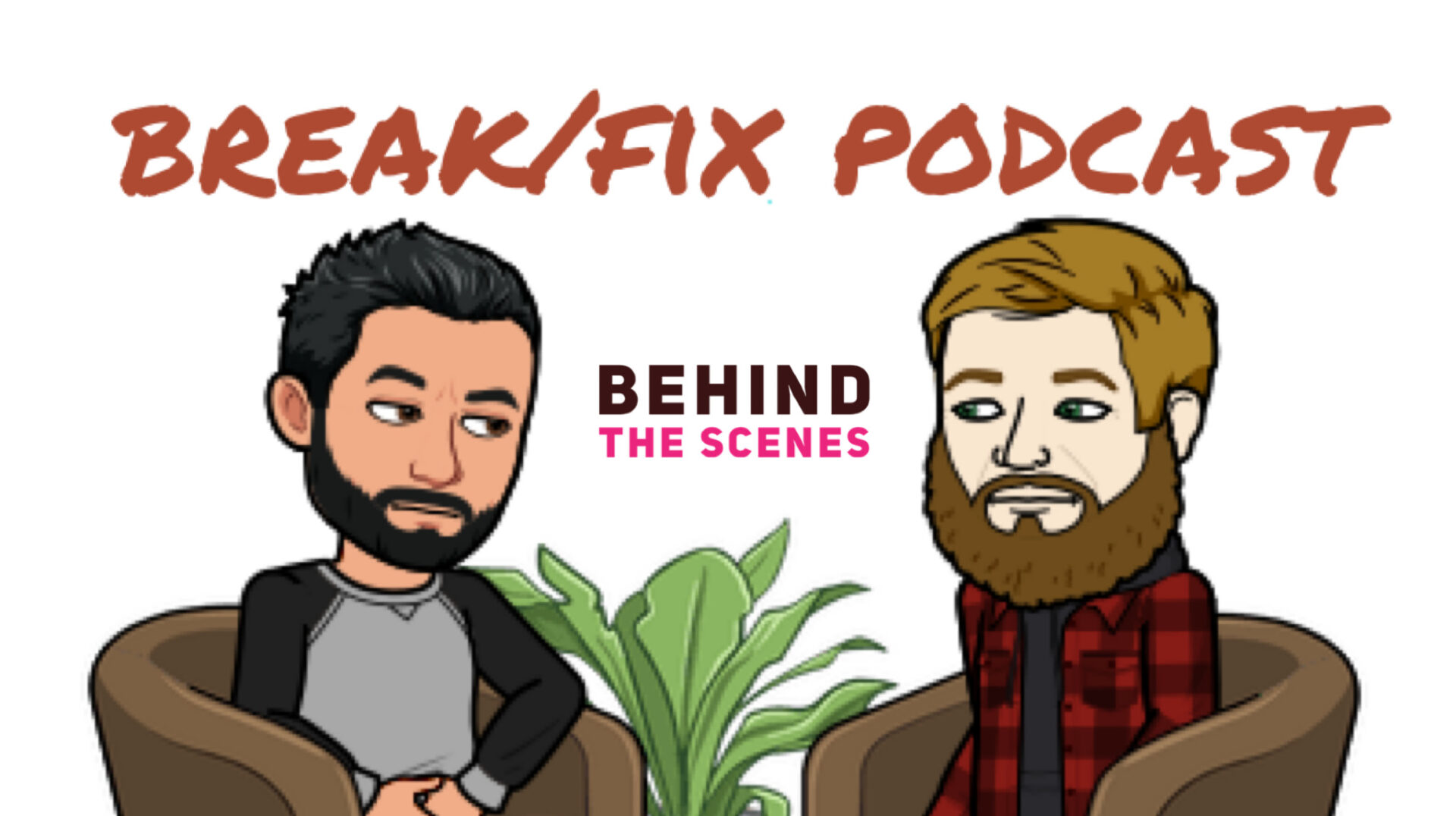
Consider becoming a GTM Patreon Supporter and get behind the scenes content and schwag!
Do you like what you've seen, heard and read? - Don't forget, GTM is fueled by volunteers and remains a no-annual-fee organization, but we still need help to pay to keep the lights on... For as little as $2.50/month you can help us keep the momentum going so we can continue to record, write, edit and broadcast your favorite content. Support GTM today! or make a One Time Donation.

If you enjoyed this episode, please go to Apple Podcasts and leave us a review. That would help us beat the algorithms and help spread the enthusiasm to others by way of Break/Fix and GTM. Subscribe to Break/Fix using your favorite Podcast App:
As a talented mechanical engineer, racer and a professional in the semi-truck world, Keri is a true trailblazer breaking down barriers and inspiring others – especially women and young ladies- to pursue their passions, no matter how unconventional they may be.
Impressive Motorsports Resume!
- SCCA Laguna Seca
- Sears Point
- Nasport high school team
- Auto shop
- Homecoming
- Mechanical engineering degree 2005
- Mini Baja
- Kinetic sculpture 2005
- Daimler 2007 CDL, winter test, cross country
- CRAWL Easter Jeep Safari 2008
- Rumblegoat Racing BITD 2009
- Porsche 1
- First Las Vegas Barrett Jackson SEMA
- Ranger 2010
- Trophy Girl Designs
- Porsche 2
- Pikes Peak 2010
- NHRA
- Central Oregon Off-road Race Park
- PACCAR 2012
- Ultra4 2011, 2012, 2013
- Monster Jam
- King of the hammers 2014
- Pikes Peak 2015
- VORRA
- Yellowknife 2019
- Pikes Peak 2022
- Bendix, J turns and collision avoidance, and GVFs on site
- Ram Runner pace truck
- Fass Racing
- Parasailing
- Power wagon x2
- Parallel park semi
- Loveland pass and I70 highest roads in US
- Crossed the continental divide like 5 times in one day, over 10k feet
- Trailer backing training


